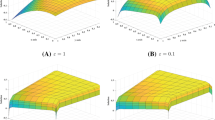Abstract
The basic aim of this study is to introduce and describe a numerical scheme for the approximate solutions of the one-dimensional singularly perturbed boundary-value problems. The method is based on Haar wavelets and its main characteristic is that, it converts the given problem into a system of algebraic equations that can be solved easily with any of the usual methods. Another distinguishing feature of the this method is that unlike several other numerical methods, it does not require conversion of a boundary value problem into initial-value problem and hence eliminates the possibility of unstable solutions. To show the accuracy and the efficiency of the method, several benchmark problems are implemented and the comparisons are given with other methods existing in the recent literature. The results of numerical tests confirm that the Haar wavelet collocation method is superior to other existing ones and is highly accurate.






Similar content being viewed by others
References
Aziz, T., Khan, A.: Quintic spline approach to the solution of a singularly perturbed boundary value problem. J. Optim. Theory Appl. 112(3), 517–527 (2002)
Aziz, T., Khan, A.: A spline method for second-order singularly perturbed boundary-value problems. J. Comput. Appl. Math. 147, 445–452 (2002)
Chen, C.F., Hsiao, C.H.: Haar wavelet method for solving lumped and distributed-parameter systems. IEE Proc. Control Theory Appl. 144, 87–94 (1997)
Debnath, L., Shah, F.A.: Wavelet transforms and their applications. Birkhäuser, New York (2015)
Geng, F.Z., Cui, M.G.: A novel method for solving a class of singularly perturbed boundary value problems based on reproducing kernel method. Appl. Math. Comput. 218, 4211–4215 (2011)
Kadalbajoo, M.K., Awasthi, A.: A parameter uniform difference scheme for singularly perturbed parabolic problem in one space dimension. Appl. Math. Comput. 183, 42–60 (2006)
Kadalbajoo, M.K., Bawa, R.K.: Variable mesh difference scheme for singularly perturbed boundary-value problems using splines. J. Optim. Theory Appl. 9, 405–416 (1996)
Kadalbajoo, M.K., Patidar, K.C.: Spline techniques for the numerical solution of singular perturbation problem. J. Optim. Theory Appl. 112(3), 575–594 (2002)
Kadalbajoo, M.K., Aggarwal, V.K.: Fitted mesh \(B\)-spline collocation method for solving self adjoint singularly perturbed boundary value problems. Appl. Math. Comput. 161(3), 973–987 (2005)
Kadalbajoo, M.K., Gupta, V.: Numerical solution of singularly perturbed convection-diffusion problem using parameter uniform \(B\)-spline collocation method. J. Math. Anal. Appl. 355, 439–452 (2009)
Kadalbajoo, M.K., Gupta, V., Awasthi, A.: A uniformly convergent \(B\)-spline collocation method on a nonuniform mesh for singularly perturbed one-dimensional time-dependent linear convectiondiffusion problem. J. Comput. Appl. Math. 220, 271–289 (2008)
Khan, A., Khan, I., Aziz, T.: Sextic spline solution of singularly perturbed boundary-value problems. Appl. Math. Comput. 181, 432–439 (2006)
Khan, A., Khandelwala, P.: Non-polynomial sextic spline solution of singularly perturbed boundary-value problems. Int. J. Comput. Math. 91(5), 1122–1135 (2014)
Kumar, V., Mehra, M.: Cubic spline adaptive wavelet scheme to solve singularly perturbed reaction diffusion problems. Int. J. Wavelets Multiresoult. Inf. Process 5(2), 317–331 (2007)
Kumar, M., Singh, P., Mishra, H.K.: An initial-value technique for singularly perturbed boundary value problems via cubic spline. Int. J. Comput. Methods Eng. Sci. Mech. 8:419–427 (2007)
Lenferink, W.: A second order scheme for a time-dependent, singularly perturbed convection-diffusion equation. J. Comput. Appl. Math. 143, 49–68 (2002)
Lepik, U., Hein, H.: Haar wavelets with applications. Springer, New York (2014)
Lepik, U.: Solving integral and differential equations by the aid of nonuniform Haar wavelets. Appl. Math. Comput. 198, 326–332 (2008)
Lubuma, J.S., Patidar, K.C.: Uniformly convergent non-standard finite difference methods for self-adjoint singular perturbation problems. J. Comput. Appl. Math. 191, 228–238 (2006)
Mallat, S.G.: Multiresolution approximations and wavelet orthonormal bases of \(L^2(\mathbb{R})\). Trans. Am. Math. Soc. 315, 69–87 (1989)
Miller, J.H., ORiordan, E., Shishkin, G.I.: Fitted numerical methods for singular perturbation problems. World Scientific, Singapore (1996)
Natesan, S., Jayakumar, J., Vigo-Aguiar, J.: Parameter uniform numerical method for singularly perturbed turning point problems exhibiting boundary layers. J. Comput. Appl. Math. 158, 121–134 (2003)
Phongthanapanich, S., Dechaumphai, P.: Combined finite volume element method for singularly perturbed reaction-diffusion problems. Appl. Math. Comput. 209, 177–185 (2009)
Rashidinia, J., Ghasemi, M., Mahmoodi, Z.: Spline approach to the solution of a singularly-perturbed boundary-value problems. Appl. Math. Comput. 189, 72–78 (2007)
Roos, H.G., Stynes, M., Tobiska, L.: Numerical methods for singularly perturbed differential equations. Springer, New York (1996)
Shah, F.A., Abass, R., Iqbal, J.: Numerical solution of singularly perturbed problems using Haar wavelet collocation method. Cogent Math. 3, 1202504 (2016)
Surla, K., Herceg, D., Cvetkovic, L.: A family of exponential spline difference schemes. Rev. Res. Fac. Sci. Math. Ser. Univ. Novi. Sad. 20, 17–26 (1990)
Surla, K., Stojanovic, M.: Solving singularly-perturbed boundary-value problems by splines in tension. J. Comput. Appl. Math. 24, 355–363 (1988)
Surla, K., Vukoslavcevic, V.: A spline difference scheme for boundary-value problems with a small parameter. Rev. Res. Fac. Sci. Math. Ser. Univ. Novi. Sad. 25, 159–166 (1995)
Wazwaz, A.M.: A new method for solving singular initial value problems in the second-order ordinary differential equations. Appl. Math. Comput. 128, 45–57 (2002)
Author information
Authors and Affiliations
Corresponding author
Rights and permissions
About this article
Cite this article
Shah, F.A., Abass, R. An operational Haar wavelet collocation method for solving singularly perturbed boundary-value problems. SeMA 74, 457–474 (2017). https://doi.org/10.1007/s40324-016-0094-9
Received:
Accepted:
Published:
Issue Date:
DOI: https://doi.org/10.1007/s40324-016-0094-9




